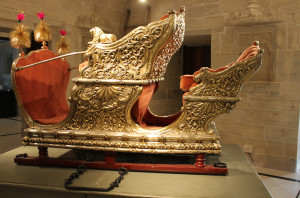 Shriji Arvind Singh Mewar, Chairman & Managing Trustee of Maharana of Mewar Charitable Foundation (MMCF) and 76th Custodian of the House of Mewar, unveiled the world’s first-ever silver museum filled with family heirlooms dating back to 743 AD. This coincided with the MMCF’s annual award ceremony in recognition of international and national scholars for their work of permanent value to society.
Shriji Arvind Singh Mewar, Chairman & Managing Trustee of Maharana of Mewar Charitable Foundation (MMCF) and 76th Custodian of the House of Mewar, unveiled the world’s first-ever silver museum filled with family heirlooms dating back to 743 AD. This coincided with the MMCF’s annual award ceremony in recognition of international and national scholars for their work of permanent value to society.
Shriji Arvind Singh Mewar of Udaipur, Chairman & Managing Trustee of MMCF and the scion of the House of Mewar, remarked upon the personal value of some of the exquisite exhibit pieces including the 1939 custom-made buggy, which formed part of the current monarch’s late mother’s dowry, and the wedding mandap where His Majesty gave away his daughter two years ago.
The nostalgic exhibit is displayed at the renowned Amar Mahal, which is located at the entrance of Zenana Mahal and said to be the inspiration for the Taj Mahal in Agra. It includes pieces ranging from beautiful objects used in rituals such as Ram Rewaris (portable shrine for religious deity), magnificent traditional royal transport like the haudah used for mounting elephants in religious, state and military processions.
Royal buggies and palanquins are also part of the exhibition. The works on display illustrate the result of the longstanding historical relationships between the House of Mewar and both the Rajput courts and the Mughal establishment, as well as showcasing indigenous artisan techniques.
The current modernization and renovation of the Zenana Mahal at the City Palace Museum is being undertaken with financial assistance from the Ministry of Culture, Government of India, New Delhi under the scheme ‘Setting Up, Promotion & Strengthening of Regional & Local Museums’.
The selection of unique items included in the silver gallery reflects the artistry of the silversmith and the beauty of this precious metal. Indian silver is remarkable for its limitless forms, noted for its technical perfection and characterised by its varied use.
Silver is held sacred in traditional Hindu beliefs, which associate the beautiful white metal with the cool moon, surpassed only in importance by warm gold. Its association with purity and religion is also the reason why silver was extensively used by Indian royalty.
Moreover, unlike gold which is highly malleable, silver is strong enough to allow the fashioning of sturdier objects and could thus be put to more robust and varied use, including transport.
